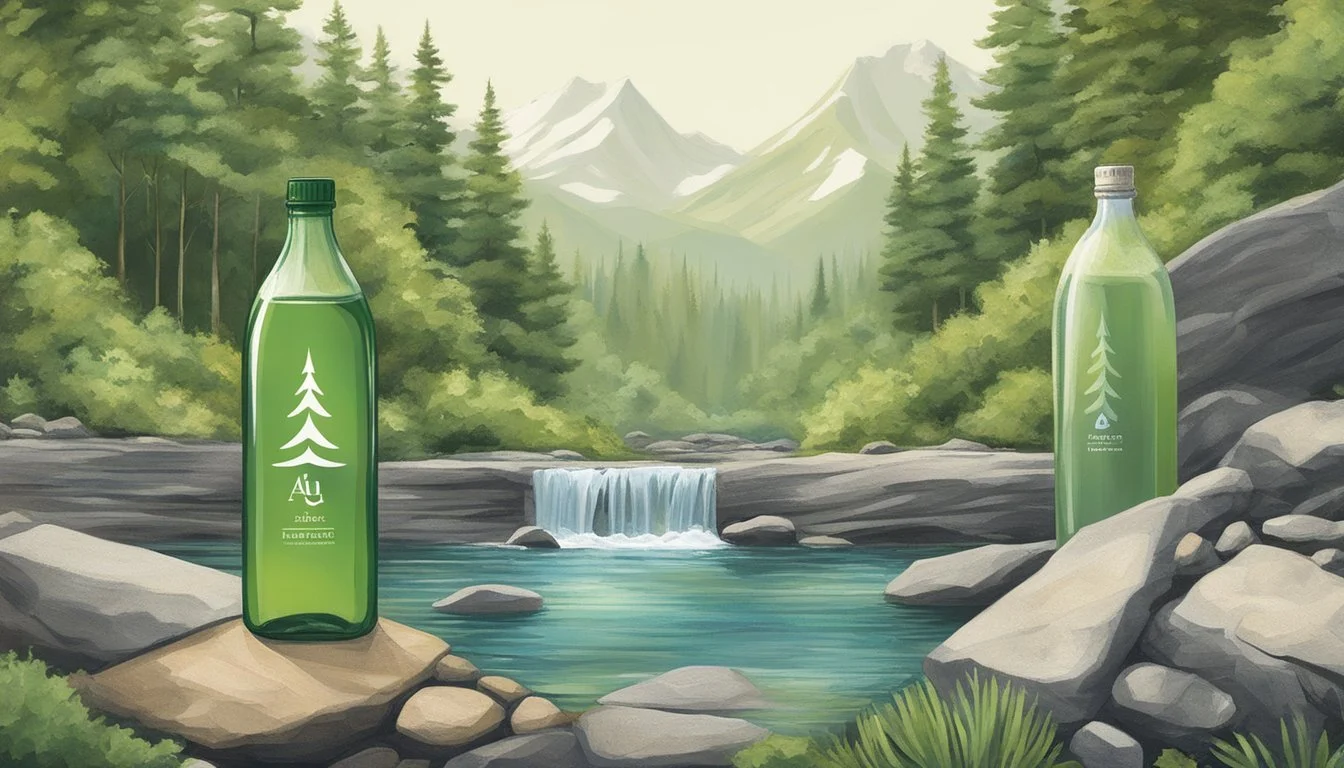Arrowhead vs. Augi
Which Bottled Water Offers Superior Quality?
Choosing the right bottled water can significantly impact one's hydration experience and health. Arrowhead, known for its spring water sourced from various mountain springs in the western United States, offers a natural and refreshing taste. On the other hand, Augi, a purified water from the municipal sources of Leesburg, Virginia, goes through a rigorous purification process to ensure high standards of purity.
Consumers often weigh factors such as taste, filtration methods, and brand reputation when deciding between bottled waters. When comparing Arrowhead and Augi, Arrowhead’s natural origin often appeals to those who prefer minimally processed, spring-sourced water, while Augi’s thorough purification process may attract consumers craving assured purity.
Whichever side of the debate you fall on, knowing the differences can help make an informed choice. This article will break down the key characteristics, taste profiles, and consumer perceptions of both Arrowhead and Augi, providing you with the insight needed to choose the best bottled water for your lifestyle.
Background on Bottled Water
Bottled water is sourced and purified through various methods to meet safety and quality standards. Understanding the types of bottled water and the regulations governing them is essential for making an informed choice.
Types of Bottled Water
There are several types of bottled water, including spring water, purified water, mineral water, and artesian water.
Spring water comes from underground formations and flows naturally to the surface. Brands like Poland Spring and Evian often market spring water.
Purified water is treated to remove contaminants and can originate from any water source, including tap water. Aquafina and Dasani are prominent examples of purified water brands.
Mineral water contains specific mineral content, which remains intact. Fiji and San Pellegrino are popular mineral water brands.
Artesian water is sourced from confined aquifers under pressure. Voss and Fiji are known for offering artesian water.
Understanding these types helps consumers choose based on preference and health considerations.
Regulations and Standards
Regulations for bottled water vary by region but generally involve stringent standards to ensure safety. In the United States, the Food and Drug Administration (FDA) oversees bottled water, whereas the Environmental Protection Agency (EPA) regulates tap water.
The FDA enforces labeling requirements and sets limits on contaminants such as lead and coliform bacteria. For brands like Nestlé Pure Life and Aquafina, compliance with these standards is mandatory.
Internationally, the World Health Organization (WHO) provides guidelines followed by many countries to ensure bottled water safety. Smartwater and LIFEWTR adhere to national and international guidelines.
Despite regulations, the impact of plastic pollution from bottled water like those from Nestlé remains a concern. Consumers should consider this environmental aspect when choosing their bottled water.
Analyzing Water Quality
When comparing Arrowhead and Augi, several factors like the source of the water, purification methods, and mineral content significantly influence their quality and appeal to consumers.
Source and Origin
Arrowhead sources its water from multiple natural springs primarily located in California. The natural springs contribute to the water's distinct taste and fresh quality.
By contrast, Augi uses water from the Leesburg, Virginia municipal supply. Although it employs advanced purification methods, its origin from municipal water may impact its perception among consumers looking for natural sources.
Sourcing methods play a key role in defining the uniqueness and appeal of each brand.
Filtration and Purification Processes
Arrowhead maintains its quality by using filtration techniques such as reverse osmosis and ozone sterilization. These processes ensure the water remains free from contaminants while preserving its natural mineral content.
Augi relies on a meticulous seven-step purification process to convert municipal water into high-purity bottled water. Augi's process involves successive stages like microfiltration, ultraviolet disinfection, and reverse osmosis to achieve a refined level of purity.
Each brand’s purification strategy highlights its approach to delivering clean and safe water.
Mineral Content and Health Benefits
Arrowhead water is known for its balanced mineral content, which includes essential electrolytes like calcium and magnesium. These naturally occurring minerals can enhance the taste and offer various health benefits, such as supporting bone health.
On the other hand, Augi's purification process results in water with a lower mineral content. Augi may add some minerals back in small quantities to improve taste, but it does not match the natural mineral richness found in Arrowhead water.
The mineral makeup of each water brand can be a crucial factor for those seeking not just hydration but added health benefits.
Environmental and Sustainability Considerations
Examining the environmental footprint of Arrowhead and Augi bottled waters is essential for understanding their impact on the planet. Key points include packaging choices and the companies' specific environmental commitments.
Packaging and Recycling Impact
Both Arrowhead and Augi use different materials for packaging.
Arrowhead, a product of BlueTriton Brands, commonly employs plastic bottles made from PET plastic. This material is lightweight and can be recycled, but it often ends up in landfills due to inadequate recycling practices. Arrowhead also offers some products in glass bottles, which are more eco-friendly, as glass is infinitely recyclable.
Augi promotes itself as an eco-friendly brand by using recycled PET (rPET) bottles. This has a lower carbon footprint compared to virgin plastic. Recycling PET significantly reduces greenhouse gas emissions and raw material usage. Augi also emphasizes recycling programs to encourage consumers to properly dispose of and recycle their bottles.
Water Brands' Environmental Commitments
Arrowhead focuses on responsible water sourcing and has initiatives aiming to reduce their carbon footprint and improve sustainability. These initiatives include reducing the plastic content in their bottles and investing in recycling infrastructure. Arrowhead's parent company, BlueTriton Brands, supports various environmentally friendly programs to enhance water stewardship and ecosystem conservation.
Augi, on the other hand, is committed to transparency in their environmental impacts. They frequently publish detailed reports on their environmental efforts, including water use efficiency and carbon footprint reduction. Augi's sustainability path includes using 100% rPET for their bottles, which decreases the amount of plastic waste and promotes a circular economy.
By focusing on packaging innovation and robust sustainability programs, both brands aim to offer products that are less harmful to the environment.
Consumer Preferences
When comparing Arrowhead and Augi bottled water, consumer preferences are often influenced by taste profile, convenience and availability, and brand reputation and loyalty. Each subtopic highlights different reasons why consumers might choose one brand over the other.
Taste Profile and Experience
Consumers often prioritize the taste of bottled water when selecting a brand. Arrowhead water is sourced from multiple springs across the western United States, which gives it a mineral-rich and slightly earthy flavor. Augi, on the other hand, is known for its consistent, clean taste that appeals to those who prefer a smoother flavor profile.
While Arrowhead’s natural taste is appreciated by some, others find Augi’s purity preferable. Both brands offer still and sparkling options, but Arrowhead has a more pronounced mineral presence which may not be suitable for all palates.
Convenience and Availability
Availability of bottled water significantly affects consumer choice. Arrowhead is widely available in many grocery stores across the western United States, making it a convenient option for those residing in this region. Augi tends to be found in more specialty markets and may not be as readily accessible in all areas.
Consumers who prioritize accessibility may lean toward Arrowhead due to its broad distribution network. Augi’s more selective distribution, while potentially limiting, also contributes to its exclusive appeal. Both brands offer various bottle sizes aimed at catering to different consumption needs, from single-serve bottles to bulk packaging.
Brand Reputation and Loyalty
Brand reputation plays a crucial role in consumer preferences. Arrowhead, backed by Nestlé Waters, has a long-standing presence in the market. Its consistent quality and emphasis on sustainability in production have garnered a loyal customer base. Augi, although newer, has made significant strides with effective marketing strategies and high-quality standards.
Arrowhead’s history and reliability appeal to those who favor established brands. Augi’s focus on innovation and premium quality attracts a different segment of consumers, often those who are seeking a more modern or premium experience. Both brands have cultivated followings that appreciate their respective strengths, from trusted reliability to cutting-edge branding.
Comparing Arrowhead and Augi
Arrowhead and Augi bottled waters differ notably in their sources and distribution methods, affecting both taste and availability. Consumer ratings also reveal insights about preferences and perceived quality.
Source and Authenticity
Arrowhead sources its water from mountain springs, specifically in the San Bernardino Mountains in the United States. This natural spring water is known for its crisp and refreshing taste, attributed to the clean mountain environment.
Augi, on the other hand, is sourced from the municipal water supply of Leesburg, Virginia. It undergoes a purification process that is less natural compared to Arrowhead's mountain spring source. Consumers often describe Augi’s taste as slightly sulfuric, bordering on fishy, which can be off-putting for some.
Production and Distribution
Arrowhead prides itself on using environmentally friendly practices. They package their water in recyclable plastic bottles and are also exploring more sustainable options like boxed water.
Augi's production involves extensive filtration processes to ensure purity, but it lacks the natural filtration benefits of mountain springs. Distribution of Arrowhead is more widespread, especially across the western United States. Augi's availability is more regional, primarily found in the eastern United States.
Consumer Ratings and Reviews
Consumer opinions about Arrowhead are generally positive, with many appreciating its natural taste and mountain spring origin. It enjoys a strong reputation among those who prefer naturally sourced water.
Augi, on the other hand, receives mixed reviews. While some consumers appreciate its purified taste, others are deterred by the slight sulfuric flavor. Ratings often reflect these divided opinions, finding Augi lower on many ranking lists compared to Arrowhead.
Both brands have loyal followings, but Arrowhead's natural sourcing and broader availability make it a preferred choice for many bottled water consumers. In contrast, Augi’s distinct taste and regional availability position it as a niche option for a smaller consumer base.





